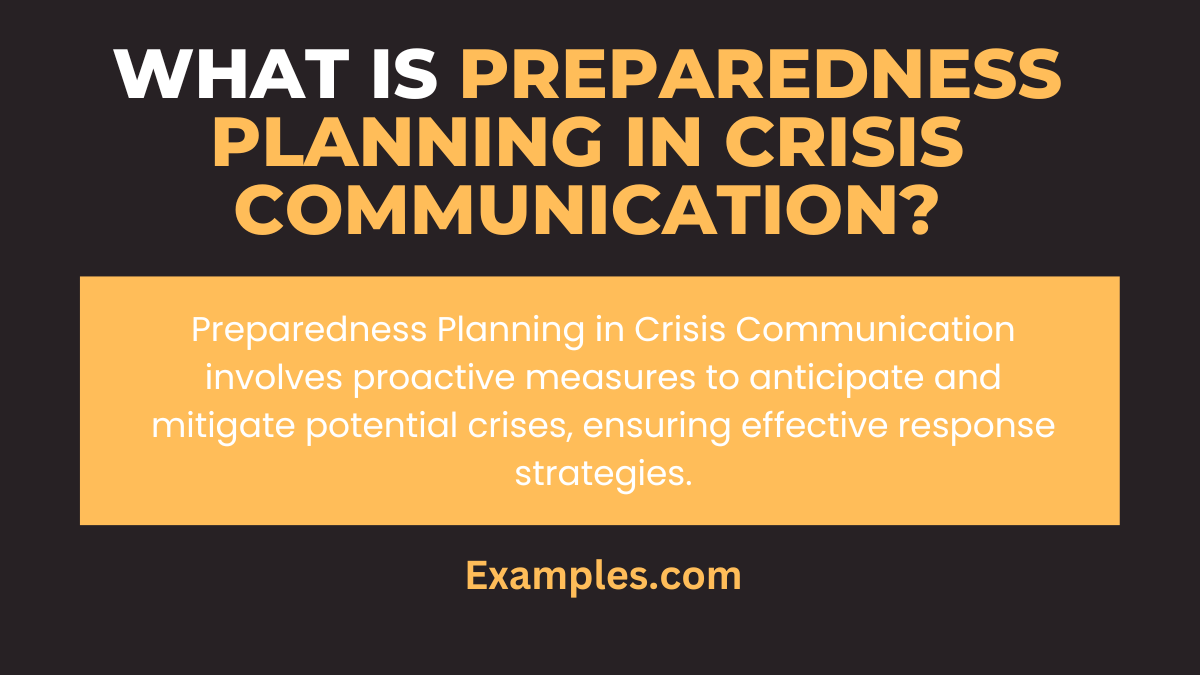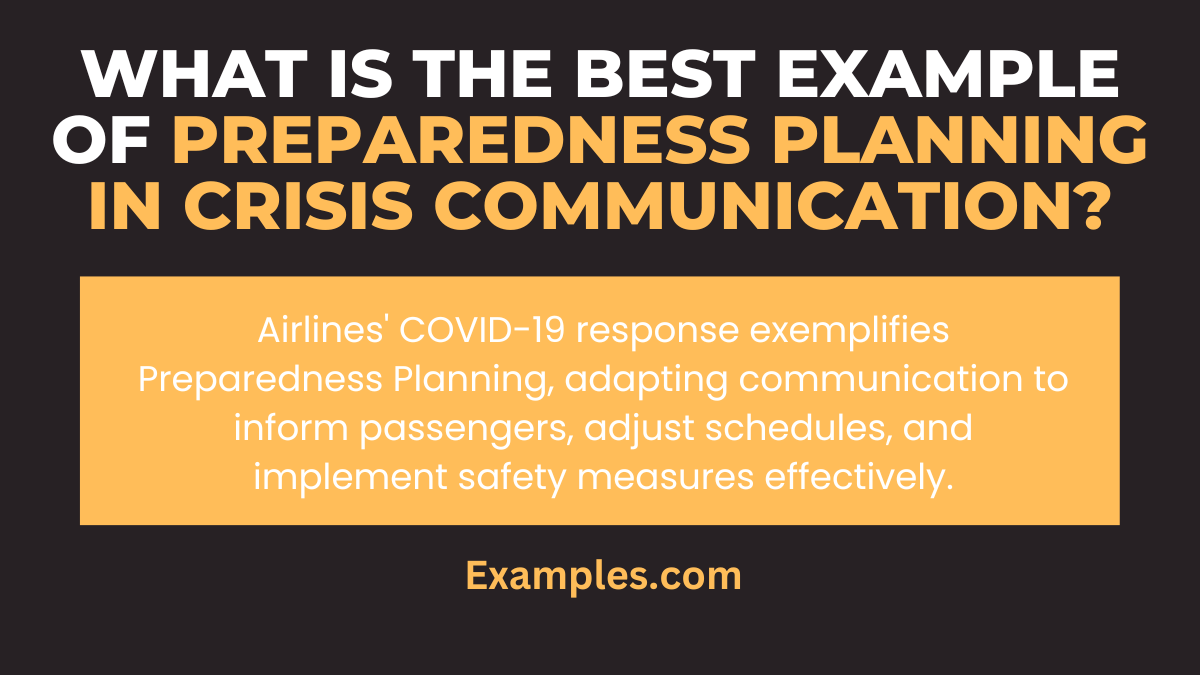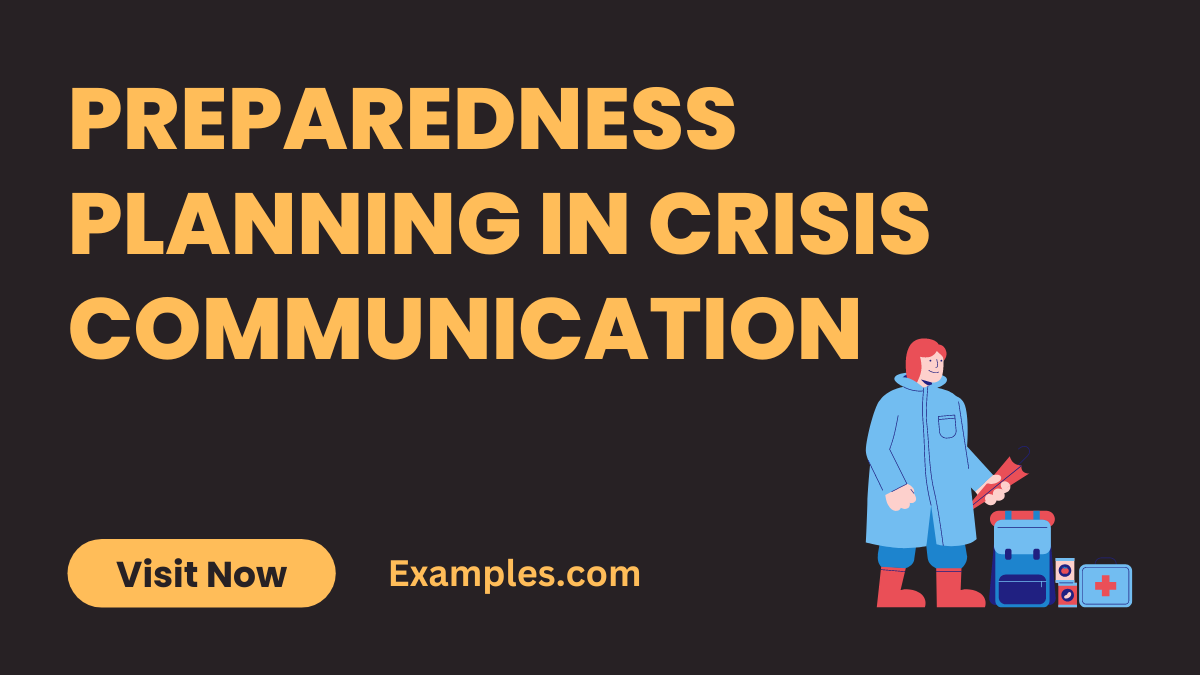19+ Preparedness Planning in Crisis Communication Examples
Embark on a comprehensive exploration of Preparedness Planning in Crisis Communication, a critical aspect for navigating turbulent times. This complete guide not only delves into strategies and tips but also illuminates the path with real-world Communication Examples. Equip yourself with the knowledge to fortify your communication strategy, ensuring resilience and efficacy in the face of unforeseen challenges. Unveil the power of preparation to transform crisis communication into a strategic advantage.
What is Preparedness Planning in Crisis Communication?

Preparedness Planning in Crisis Communication refers to the strategic process of proactively readying an organization for potential crises. It involves anticipating risks, formulating response strategies, and equipping teams with the necessary tools and knowledge to navigate challenges effectively. This approach ensures a swift, coordinated, and well-informed response, minimizing the impact of crises on reputation and operations. Preparedness Planning establishes a foundation for resilience, allowing organizations to face uncertainties with confidence and
What is Best Example of Preparedness Planning in Crisis Communication?

One exemplary instance of Preparedness Planning in Crisis Communication is demonstrated by the airline industry’s response to the COVID-19 pandemic. Airlines, having contingency plans in place, swiftly adapted their communication strategies. Proactive measures included transparently informing passengers, adjusting flight schedules, and implementing stringent safety protocols. This comprehensive approach showcased the effectiveness of preparedness planning, allowing the industry to navigate the unprecedented crisis with agility, resilience, and a commitment to passenger well-being.
20 Preparedness Planning in Crisis Communication Examples

Explore 20 real-world instances illustrating the power of Preparedness Planning in Crisis Communication. This curated collection offers insights into strategic readiness, providing valuable examples to fortify your communication approach during challenging times.
- Natural Disaster Response (2019): Swiftly executed a crisis plan, ensuring accurate communication and minimizing disruptions during a severe weather event.
- Pandemic Preparedness (2020): Organizations with robust pandemic plans navigated COVID-19 challenges seamlessly, prioritizing employee safety through clear communication.
- Cybersecurity Breach Management (2018): Faced with a data breach, a company activated preparedness plans, promptly communicating the incident and implementing security measures.
- Product Recall (2016): A proactive recall plan enabled a swift response, with clear communication on product safety, rebuilding trust amidst a challenging recall scenario.
- Hostile Takeover Readiness (2017): Demonstrated preparedness in crisis communication, providing stakeholders with transparent information during a hostile takeover attempt.
- Social Media Crisis Management (2021): Leveraged preparedness planning to address a viral social media crisis, ensuring a timely, accurate, and well-coordinated response.
- Supply Chain Disruption (2015): Preparedness ensured effective communication, keeping stakeholders informed during a supply chain disruption with transparency and accuracy.
- Employee Strike Response (2018): Managed an employee strike by executing a well-prepared communication plan, minimizing disruptions and addressing concerns openly.
- Health and Safety Protocol Activation (2017): Activated health and safety protocols seamlessly, communicating changes effectively to employees and maintaining operational continuity.
- Financial Market Volatility (2016): Financial institutions adeptly communicated during market volatility, showcasing the efficacy of preparedness planning in a dynamic economic landscape.
- Brand Reputation Crisis (2014): A brand with a crisis communication plan in place managed a reputation crisis by swiftly addressing concerns, mitigating damage, and rebuilding trust.
- Political Uncertainty (2019): Organizations navigated political instability by activating preparedness plans, ensuring stakeholders received accurate and timely information.
- Merger and Acquisition Communication (2018): Executed a merger communication plan, addressing uncertainties, and ensuring a smooth transition for employees and stakeholders.
- Terrorist Threat Preparedness (2015): Responded to a terrorist threat with a well-prepared communication strategy, prioritizing public safety through accurate information dissemination.
- Customer Data Breach (2017): Faced with a data breach, a company’s preparedness planning included transparent communication to affected customers, preserving trust.
- Employee Downsizing (2016): Proactively communicated during downsizing, utilizing a preparedness plan to address employee concerns and maintain morale.
- Market Competition Crisis (2019): Navigated a market competition crisis with preparedness planning, ensuring stakeholders were well-informed and confident in the organization’s strategy.
- Environmental Sustainability Communication (2020): Activated a sustainability crisis plan, communicating environmental initiatives transparently to mitigate potential reputation damage.
- Legal Litigation Response (2018): Demonstrated crisis communication preparedness during legal challenges, ensuring stakeholders were informed accurately and promptly.
- Community Relations Crisis (2017): A community relations crisis was managed with a preparedness plan, prioritizing open communication and resolution to maintain positive relations.
Preparedness Planning in Crisis Communication Examples for Students
Uncover Preparedness Planning in Crisis Communication through examples tailored for students. This guide offers insights into strategic readiness, ensuring students navigate challenges with effective communication skills.
- School Emergency Drill (2019): During an emergency drill, students followed a preparedness plan, showcasing the importance of clear communication and quick, orderly actions.
- Online Learning Transition (2020): Preparedness in transitioning to online learning involved effective communication to students, ensuring a smooth educational shift amidst unexpected challenges.
- Student Protest Management (2018): A university managed a student protest using a preparedness plan, communicating openly and resolving issues through strategic dialogue.
- Health Crisis Communication (2021): Amid a health crisis, a university activated preparedness plans, effectively communicating safety measures and updates to students.
- Campus Security Alert (2017): A security alert prompted by an incident illustrated the importance of preparedness planning, ensuring students received accurate and timely information.
Preparedness Planning in Crisis Communication Examples in Business
Explore Preparedness Planning in Crisis Communication within the business realm. This guide showcases real-world examples, highlighting the strategic readiness needed for effective crisis management.
- Supply Chain Disruption (2019): A business navigated a supply chain disruption using a preparedness plan, communicating transparently with stakeholders to minimize disruptions.
- Mergers and Acquisitions (2020): During a merger, effective communication was vital. Preparedness planning ensured a seamless transition, addressing uncertainties and maintaining stakeholder confidence.
- Financial Market Turbulence (2018): Financial institutions adeptly communicated during market turbulence, emphasizing the importance of preparedness planning in dynamic economic scenarios.
- Brand Reputation Crisis (2016): A brand faced a reputation crisis, leveraging a preparedness plan to swiftly address concerns, mitigate damage, and rebuild trust.
- Legal Litigation Response (2017): Demonstrating crisis communication preparedness during legal challenges, a business ensured stakeholders were informed accurately and promptly.
What Should Be Included in Preparedness Planning in Crisis Communication?
Preparedness Planning in Crisis Communication involves a strategic approach to ensure effective response and resilience. Key components to include are:
- Risk Assessment: Identify potential crises and their impact on communication.
- Communication Team Formation: Assemble a dedicated team with assigned roles and responsibilities.
- Scenario Planning: Anticipate various crisis scenarios and develop tailored communication strategies.
- Clear Communication Protocols: Establish precise channels and methods for disseminating information.
- Pre-approved Messages: Develop pre-drafted messages for common crisis scenarios, ensuring accuracy and consistency.
- Media Training: Equip communication teams with the skills to navigate media interactions effectively.
- Regular Drills and Exercises: Conduct mock crisis scenarios to test the efficiency of communication plans.
- Technology Integration: Leverage communication tools and technologies for swift information dissemination.
Why Preparedness Planning in Crisis Communication is Important?
The importance of Preparedness Planning in Crisis Communication lies in its ability to:
- Minimize Response Time: A well-prepared plan enables quick response, minimizing the time between recognizing a crisis and communicating a resolution.
- Maintain Credibility: Preparedness instills confidence, allowing organizations to communicate transparently, maintaining credibility even in challenging times.
- Reduce Impact: Strategic planning helps minimize the impact of crises on reputation, operations, and stakeholder relations.
- Facilitate Coordination: Preparedness ensures a coordinated response, preventing confusion and aligning communication efforts across teams.
- Build Resilience: Effective planning builds resilience, enabling organizations to adapt and navigate crises with agility.
What Are the Steps for Preparedness Planning in Crisis Communication?
Effective Preparedness Planning in Crisis Communication involves the following steps:
- Conduct a Comprehensive Risk Assessment: Identify potential crises and their impact on communication strategies.
- Establish a Crisis Communication Team: Assemble a dedicated team with defined roles and responsibilities.
- Develop Scenario-Specific Communication Strategies: Tailor communication plans for various crisis scenarios, considering unique challenges.
- Create a Clear Communication Protocol: Define precise channels, methods, and approval processes for effective information dissemination.
- Draft Pre-Approved Messages: Develop standardized messages for common crisis situations, ensuring accuracy and consistency.
- Provide Media Training: Equip team members with the skills to effectively communicate in media interactions.
- Conduct Regular Drills and Exercises: Simulate crisis scenarios to test the efficiency of communication plans and identify areas for improvement.
- Integrate Technology Solutions: Leverage communication tools and technologies for real-time information dissemination and updates.
In conclusion, Preparedness Planning in Crisis Communication serves as the linchpin for effective response strategies. This comprehensive guide has unveiled the critical components, importance, and actionable steps for organizations to navigate crises successfully. Armed with real-world examples, it emphasizes the significance of strategic readiness, ensuring seamless communication, credibility maintenance, and resilience in the face of challenges.



